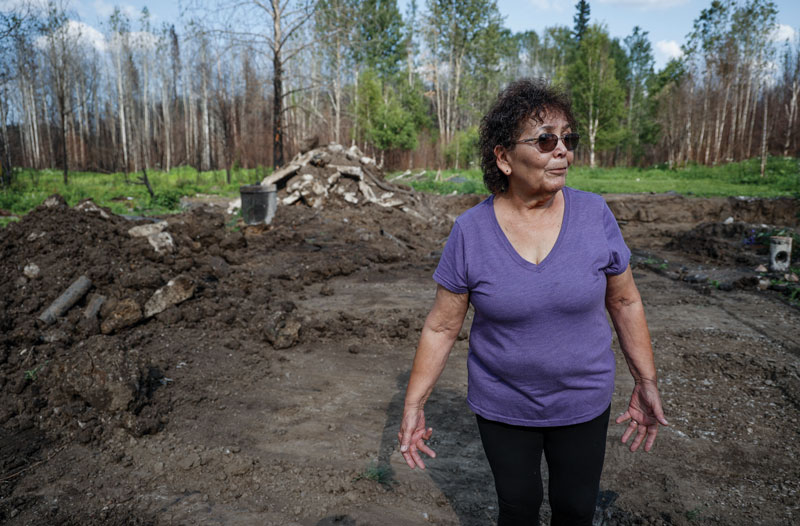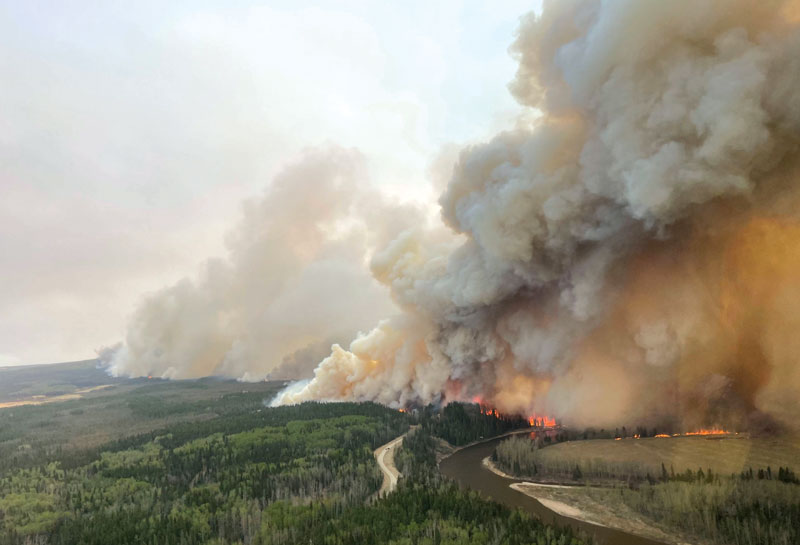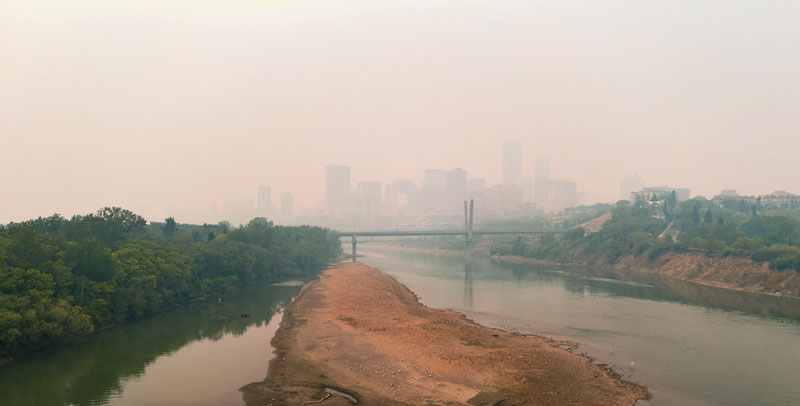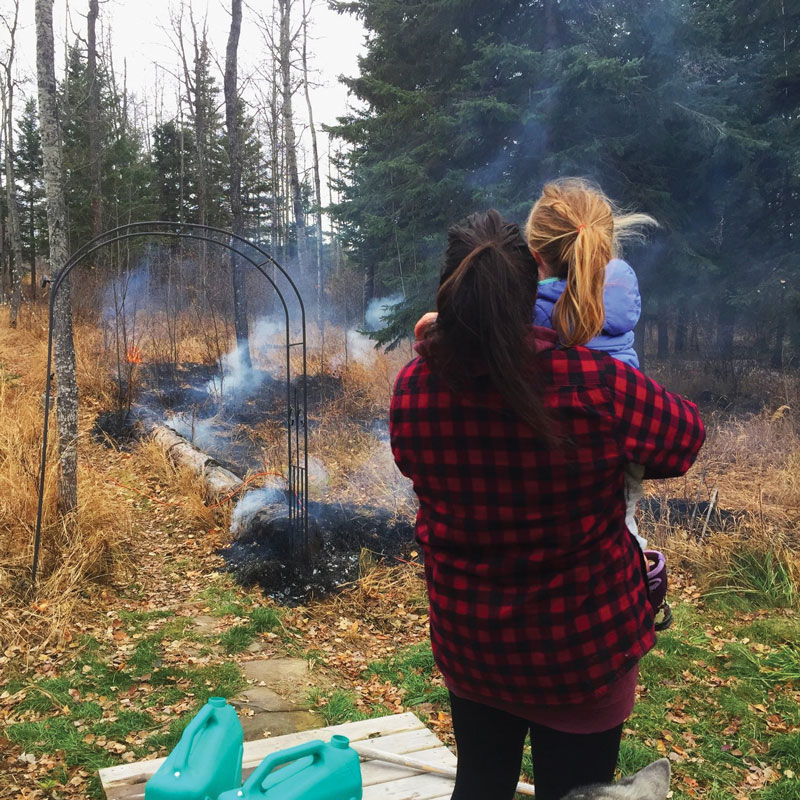Amy Cardinal Christianson grew up in northern Alberta on Treaty 8 with what she calls “good fire,” or “the kind you can walk beside”—low-intensity fires set when the conditions are cool and damp. Cultural fire, used by Indigenous peoples for centuries as a tool for promoting berry growth and habitat for moose and deer, has long been part of her story.
As someone who spent her childhood in the forest, “I experienced wildfires,” says Cardinal Christianson, who is a member of the Métis Nation of Alberta and now works as an Indigenous fire specialist with Parks Canada. “But I never remember what we’re seeing today.”
Last May when wildfires sparked and raged out of control across Alberta, prompting numerous evacuations, Cardinal Christianson found herself on deployment to the Paskwa base near Fox Lake as an Indigenous liaison on a provincial incident command team. Fox Lake is one of three communities on Little Red River Cree Nation, just over an hour’s drive east of High Level. The Paskwa Fire, which was first detected on May 2, prompted the community’s evacuation on May 3.
“The fire completely destroyed the community,” says Crystal McAteer, mayor of High Level, to which many of Fox Lake’s 3,700-residents fled. Out-of-control wildfires on the opposite side of High Level likewise threatened the communities of Chateh and Rainbow Lake, resulting in even more people ordered to evacuate to High Level.
More than 100 homes and 200 structures in Fox Lake were burned by the Paskwa Fire. The land that people depend on for survival, including hunting and gathering, was blackened.
For Indigenous communities, which are disproportionately impacted by wildfire, comprising 42 per cent of evacuation events in Canada, the losses are catastrophic. Even if your house is still standing, “you’ve lost everything that connects you to the landscape,” says Cardinal Christianson. “It can take generations for those forests to grow back.”
The 2023 wildfire season prompted the evacuation of 48 communities and 38,000 people in Alberta. Several communities were evacuated more than once. Choking smoke spread across the province, leading to numerous air-quality warnings and to Edmonton activating its first-ever “extreme weather” response. A record-breaking 2,214,958 hectares burned and several communities were destroyed, including East Prairie Metis Settlement, northwest of Edmonton, which lost 40 homes to a fire on May 5.
But experts have long been anticipating a season like this one. The situation in Alberta last May was “like a freight train coming,” says Mike Flannigan, whose research on wildfire ecology spans 40 years. “The weather forecasters were saying, ‘Look out, a classic situation is coming, batten down the hatches.’ ”
The most destructive and costly wildfires in Alberta’s recent history have ignited and spread in early May, including fires that devastated Slave Lake in 2011 and Fort McMurray in 2016, and threatened High Level in 2019. The risk for wildfires during the “spring window,” a period after the snow melts and before green-up when there’s a lot of dead organic material, occurs well across Canada, but Alberta is the busiest province come May, says Flannigan.
“There’s more people working and recreating in the forest during this time,” he says. “The weather conditions—hot, dry and windy—are very conducive to fire spread.”
What did shock Flannigan in 2023 was the way extreme fire weather persisted through the length of the summer into fall. Blocking ridges—atmospheric patterns that occur when centres of high pressure or low pressure set up over a region and prevent other weather systems from moving through—occurred over large expanses of the country. Hot, dry weather catalyzed fire spread.
“A lot of people will say, ‘Oh it’s our forest management practices or land-use practices that are causing the change in our fire activity,” says Flannigan. “Sorry, but those are really bit players. It’s climate change, climate change, climate change.”
On September 23 the Basset Fire, southwest of High Level—which had ignited in early June—was reawakened by extreme winds. It exploded out of control and destroyed the power supply to Chateh, Rainbow Lake and Zama City. The Dene Tha’ First Nation issued an evacuation order for Chateh, and with the main highway cut off, residents travelled for six hours on a bush road to reach safety. “They arrived at five o’clock in the morning and were just beat,” says McAteer. “This had been their third time [being evacuated] to High Level in a year.”
The Basset Fire’s excursion (when a fire jumps beyond a contained perimeter) on September 23 contributed to a record-breaking day in Canada, says Flannigan, with more area scorched—700,000 hectares—than on any other day in modern record.
Across the country, 18.5 million hectares burned during the 2023 season, obliterating the previous record of seven million in 1995. But according to Flannigan, what’s most eye opening is the impact, including the loss of structures, wildlife and firefighters’ lives, the effects of smoke inhalation, and the evacuation of more than 200,000 Canadians.
What’s certain, he says, is that the wildfire situation here is only going to get worse. “It’s only going to get crazier. Expect more fire and smoke in our future. Expect more community impacts. These fires will continue, and maybe increase in frequency and intensity.”
The uncertainty remains: What are we going to do about it?

Carrol Johnston stands where her house used to be before it burned in a wildfire, May 5, in East Prairie Métis Settlement
In 2021 Alberta cut 247 positions, 57 in wildfire management. “We started 2023 with a big deficit of people power.”
Alberta Wildfire entered the 2023 fire season short-staffed, says Mike Dempsey, vice-president of the Alberta Union of Provincial Employees (AUPE). This was because of provincial government cuts to permanent and seasonal staff positions. “In 2021 Agriculture and Forestry cut 247 positions, and 57 of those were in wildfire management,” says Dempsey. “We started this season with a big deficit of people power.”
Alberta’s legislated fire season starts March 1 and ends October 31. Despite this, in 2022 the provincial government shortened seasonal contracts of wildland firefighters—including radio dispatchers, lookout observers, camp bosses and those who work in logistical roles—by three to four weeks. This meant, says Dempsey, that many firefighting members were still in training when the 2023 wildfires broke out.
Alberta Wildfire is also facing serious retention issues with firefighters, many of whom have left the agency to pursue firefighting careers with the British Columbia Wildfire Service, which offers extended hiring seasons and healthcare benefits. The firefighting “brain drain” to other provinces or wildfire agencies has caused seasonal staff to shrink by 30 per cent, says Dempsey. “The pool for this kind of knowledge on the front line of a wildfire is small,” he says. “There’s competition across the country for high-quality firefighters. You can’t just hire people off the street to go into these extreme fire situations.”
After leaving itself short-handed, the Alberta government resorted to importing 4,000 firefighters from other provinces and countries, including the US, Mexico and Australia. In early May, with 88 wildfires burning across the province, Alberta called in the Canadian military—although, says Dempsey, the premier delayed five days before requesting support from the federal government.
Mayor McAteer, who remembers how the Chuckegg Creek Fire came dangerously close to High Level in 2019, says she saw the impacts of government cuts on wildfire response in 2023. “By the end of August the pay periods for seasonal firefighters were done,” she says. “They broke apart the camp and took the [water] bombers and helicopters, even though a wildfire was coming at us.”
In mid-September, when the Bassett Fire exploded, McAteer says she had to phone the Minister of Forestry and Parks, Todd Loewen, to request resources. “Our communities are in danger,” she told him.
When major wildfires threaten communities in Alberta, the government deploys an “incident command team” made up of highly trained and experienced permanent staff to manage wildfires. Previously the province had four of these teams. In 2023 they were cut down to two. This meant permanent staff were working double time, upwards of seven deployments. Says Dempsey: “Fatigue and burnout start to happen.”
The Alberta government needs to invest more in its wildfire management program to recruit and retain firefighters. “You can’t do more with less, so we need to spend more money on this,” Flannigan says. He argues spending now will save more money later, not just from having to constantly recruit and train firefighters but from having to import firefighters from across the world and pay staff overtime.
This doesn’t necessarily mean putting money into aircraft or sustained action efforts. According to Flannigan, we simply need “boots on the ground to put the fire out.” “You can kill any wildfire small,” he says. “We need extra resources in initial attack.”
He points to the public misconception that aircraft dropping loads of clay retardant is an effective means of extinguishing a wildfire. “If the fire is really small, it may be helping,” he says. “But if a wildfire is large, it’s like spitting on a campfire.”
The most significant cause of big wildfires is lightning. Of the 2,211,900 hectares that burned in Alberta in 2023, 1,750,867 burned because of lightning. Still, the number of human-caused wildfires is a concern. In 2023 the province responded to 659 human-caused wildfires. (The cause of 48 fires remains under investigation.) “We can do better,” says Flannigan. “People-caused fires are preventable.” The province needs to implement fire bans and forest closures before critical burning days, he says, particularly in early May after the snow melts but before the forest leafs out, or when periods of extreme fire weather—heat and drought—are forecasted. “Forest closures are very unpopular with the public and industry,” Flannigan adds, “but extremely effective at preventing wildfires.”
These closures are exactly what they sound like: halting industrial activity such as logging or oil extraction and prohibiting recreational activities such as hiking, camping or driving ATVs. The province of Nova Scotia implemented a forest closure last May after its wildfire situation escalated and had consumed 200 homes.
The wildfire scientist is also urging the government of Alberta to implement mandatory “fire smarting” around homes. Fire-smarting refers to vegetation management to reduce the fuels that can easily catch flame. Fire is “opportunistic,” says Flannigan. It’s always looking for a place to burn and spread. Out-of-control wildfires can cast burning embers—bits of needles and twigs—and ignite additional “spot fires.” In 2011, spot fires were starting in Slave Lake despite the wildfire front being more than two kilometres from town.
“When the rain of burning embers hits a home that didn’t ‘fire smart,’ it catches fire and spreads structure to structure,” Flannigan says. “It’s like a breach in a dam. Once it goes, it’s gone.” He advocates that people in Alberta’s fire-prone communities be required to remove flammable fuels within 1.5 m of their homes. California—another jurisdiction all too familiar with wildfire—already requires the removal of flammable material within five feet, or the equivalent of 1.5 m.
But this isn’t all that’s needed, argues Werner Kurz, a senior research scientist with the Canadian Forest Service of Natural Resources Canada. He says Alberta and other provinces need to readdress their forest management practices to prevent fires.
For decades, Alberta has predominantly managed the boreal forest for timber production, harvesting and replanting plots with coniferous species only, including pine and spruce. These trees are highly flammable and contribute to the rapid spread of fires, says Kurz, whereas broadleaf species such as aspen typically slow down or stop the flames: “Aspen, birch and maple, any of the trees that have leaves rather than needles, hold a lot of moisture.”
The forestry industry, however, has historically suppressed the growth of aspens through broad application of herbicides or through mechanical clearing (cutting down saplings). Kurz says provinces must take a design approach and determine “ignition points” on the landscape—places where fires tend to start, due to people or lightning—and plant tree species accordingly. “It wouldn’t be a checkerboard,” says Kurz. “It would be a design where we could, say, have a strip of broadleaf species that would reduce the fire risk and become a natural firebreak.”
Alberta needs to readdress the spatial arrangement of our forests and encourage more open forest, with conifers interspersed with broadleaf species. Says Kurz: “It’s about making it more difficult for fires to spread from one fuel to the next.”
It’s far less costly to prevent forest fires than to extinguish them.
As climate change creates more wildfires, more smoke and more community evacuations, our communities need to be ready and our government needs to provide them support. “Every community should have an emergency management plan that focuses on prevention, mitigation, preparedness, response and recovery,” says Flannigan. It’s far less costly to invest in preventing wildfires from exploding out of control than it is to extinguish them or rebuild infrastructure afterwards, he says, with “every dollar spent saving us $5 to $15 down the road.”
One of the most critical aspects of preparedness, says Flannigan, is being able to efficiently and safely evacuate people from their homes and communities. People need to consider escape routes, including roads in and out of neighbourhoods or communities, and green spaces, including golf courses and football fields that can serve as fire breaks.
He references a situation that occurred in Kamloops, BC, in 2021 when a wildfire threatened a neighbourhood with hundreds of homes but only one access road. “It was a complete bottleneck—a disaster waiting to happen,” he says. “Fortunately, a rainstorm came along. They were exceedingly lucky. It could have been much worse.”
In July 2023 Ron Bellerose, chair of the East Prairie Metis Settlement, spoke out about the community’s decade-long struggles to obtain provincial support to build a second road out of the community. “There’s only one escape route in East Prairie, and that’s the scary part,” he told CBC News.
When wildfires enter a community, one of the first things to be impacted is power, followed by water pressure. In addition to escape routes, residents could benefit from an investment in wildfire evacuation centres, says Flannigan, where people can seek safe refuge while accessing essential services. High Level is proposing to build such a centre with the capacity to house upwards of 2,000 people. Mayor McAteer says the town signed a friendship agreement with the Dene Tha’ First Nation to move forward with the idea, which was generated following the Chuckegg Creek wildfire in 2019.
“We recognize that more and more people are coming here,” says McAteer. “It’s easier to have people in one facility, where they can get the same information and they’re looked after.” The centre would provide food, water and medical and interpretive services to evacuees, many from nearby Indigenous communities.
And while High Level serves a regional population of 30,000, it also provides services to communities in the Northwest Territories. “NWT evacuees came through town this past summer,” says McAteer, referring to the wildfires that evacuated multiple communities, including the city of Yellowknife. “Many of them travelled for 17 hours through wildfires. They were so traumatized.”
Some of the NWT evacuees stayed in High Level and slept in the town’s arena. Others camped out in local farmers’ fields and pastures. The town and the Dene Tha’ First Nation are lobbying for provincial and federal support to build the centre, says McAteer, although it’s been a struggle to rally the funds—upwards of $40-million. But McAteer points out that over the long term it’s cheaper to build an evacuation centre to house people locally than to pay for food and housing for evacuees in larger cities, including Peace River, Grande Prairie and Edmonton. “We can do it right here for less,” she says.
In light of the disproportionate impact of wildfire on First Nations communities in the province, Amy Cardinal Christianson wants to see more Indigenous people involved in higher-level decision making. She’s advocating for a fire guardian program, which would employ Indigenous peoples on their traditional territories, year-round, monitoring and responding to wildfire in culturally relevant ways.
She says the legacy of wildfire suppression in Alberta has contributed to the crisis we’re seeing today. By attempting to extinguish all fire on the landscape, we’ve in turn created highly flammable stands of forest. Combined with the effects of climate change, fires explode into infernos.
“For me, the answer isn’t only investing in larger firefighting forces, because [suppression] perpetuates the problem we’re already seeing from the colonial regulation of fire,” Cardinal Christianson says. “A Fire Guardian movement is about building a better relationship with fire. Having fire on the ground when it’s safer, and doing mitigation work around communities and by communities that directly benefit from it.”
Cardinal Christianson wants people to understand that her fires are not the same as prescribed burns. The practice depends on close observation of the land and weather, as opposed to Western concepts such as the Fire Weather Index, used by agencies across Canada. “An elder once told me that he knew when it was time to burn based on the plumpness of spruce needles,” says Cardinal Christianson. “Now Western scientists have a term for that; they call it the ‘foliar moisture content.’ ”
She’s advocating for year-round investment to support Indigenous-led fire stewardship in Alberta. “When there’s an extreme fire event, the floodgates open in terms of funding. It’s unlimited how much money you can throw at a fire,” says Cardinal Christianson. “But there’s never the kind of funding during the off-season for communities to mitigate fire risk or to carry out fire practices.”
She points to the success of Indigenous Fire Guardian programs in other countries, including Australia and the US, which are seeing the positive results of supporting communities year-round to monitor and mitigate for wildfires on their traditional lands.
Cardinal Christianson and her colleagues are trying to educate people about the importance of Indigenous-led cultural burning on the landscape, a technology that was never lost, despite the fact that it was banned in the early 1900s in Alberta.
This past fall when the conditions were cool and damp, she and her family implemented a small burn on her property in northern Alberta. “My kids were playing in a leaf pile right next to where we were putting fire on the ground,” she says. “It doesn’t have to be a scary thing—fire can be good.”
Trina Moyles’s Lookout: Love, Solitude and Searching for Wildfire in the Boreal Forest (Penguin, 2021) is about
her time working at a fire tower in northern Alberta.
____________________________________________




